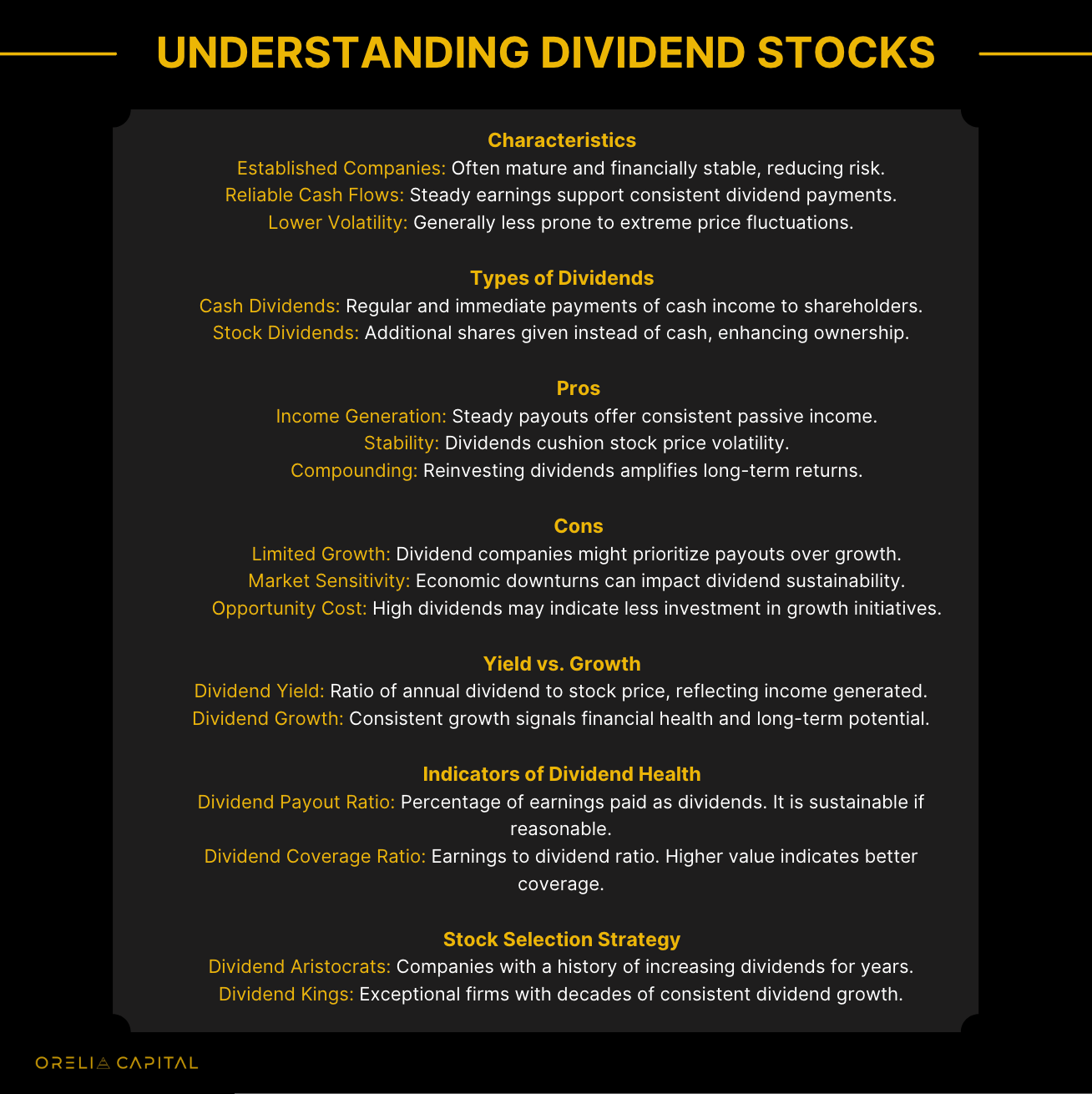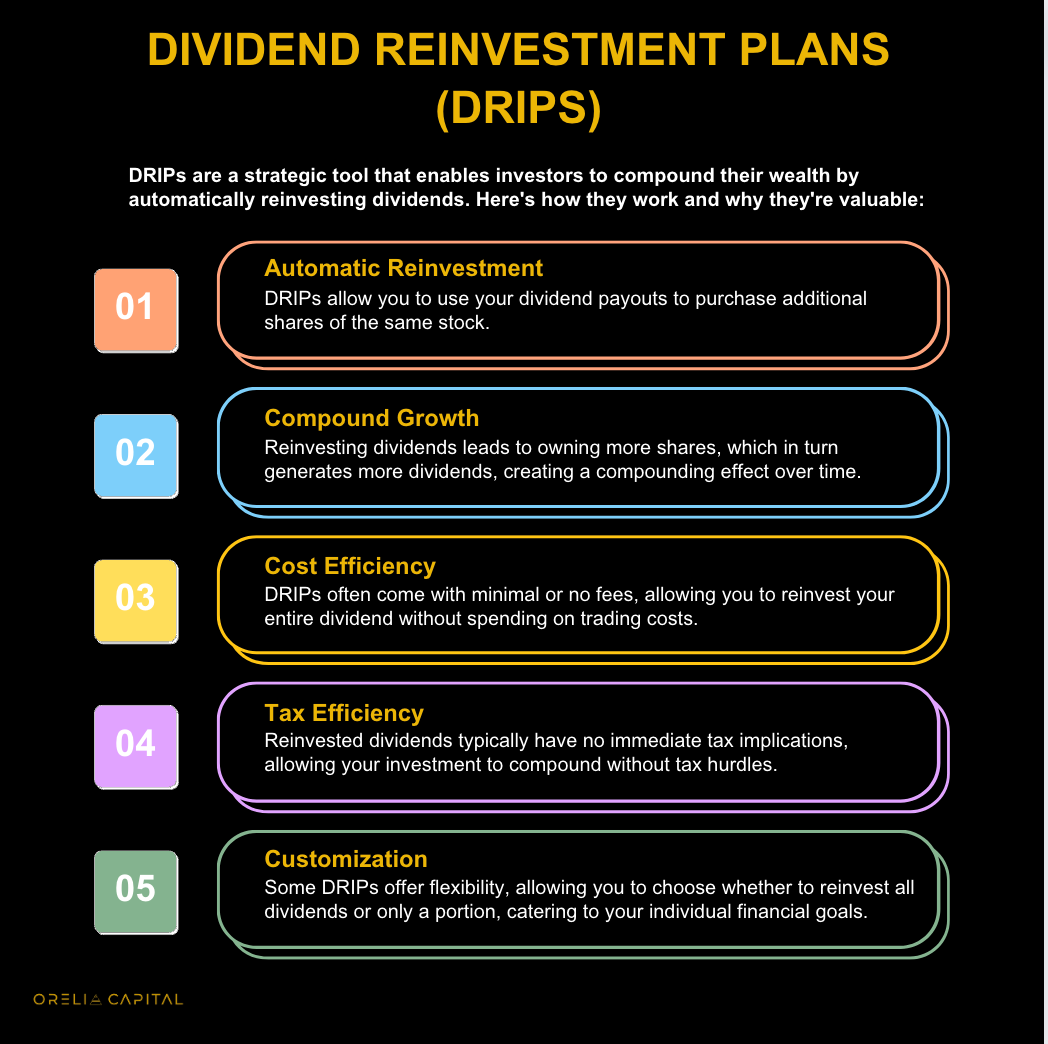Dividend Investing: Your Path to Passive Income

Introduction to Dividend Investing
Unveiling Dividends:
- Dividends are a portion of a company's profits distributed to shareholders.
- They provide investors with a steady income stream akin to rent from real estate.
The Mechanism:
- Companies declare dividends periodically, often quarterly, from their earnings.
- Investors holding dividend-paying stocks receive a proportional share based on the number of shares they own.
A Reliability Factor:
- Unlike fluctuating market values, dividends offer consistent income.
- This reliability makes them a cornerstone for building passive income.

- Selective Choices: Opt for companies with consistent dividend growth and strong financials.
- Compounding Power: Reinvested dividends multiply over time, enhancing wealth.
- Long-Term Approach: Patience is vital for compounding to yield substantial results.
- Inflation Hedge: Rising dividends maintain purchasing power against inflation.
- DRIPs for Growth: Utilize dividend reinvestment for compounding benefits.
- Balanced Gains: Dividend growth stocks offer income and potential appreciation.
- Steady Discipline: Patiently hold through market fluctuations for rewards.
Dividend Tax Considerations:
Tax Implications: Understand that dividend income is subject to taxation but often at a lower rate than other forms of income.
- Qualified dividends are taxed at capital gains rates, which can be advantageous.
- Non-qualified dividends are taxed at ordinary income rates.
Tax-Efficient Strategies: Implement strategies to minimize tax impact on your dividend income.
- Utilize tax-advantaged accounts like Individual Retirement Accounts (IRAs) to shelter dividends from immediate taxation and long-term holding for optimal tax efficiency.
Dividend Tax Rates: Familiarize yourself with the tax rates applicable to different income levels.
- Being aware of tax brackets helps manage your tax liability in strategic planning.
Foreign Dividend Taxation: Understand how dividends from international companies are taxed.
- Some countries have tax treaties that may impact the withholding tax on foreign dividends.
Consult a Tax Professional: Given the intricacies of tax laws and regulations, seeking advice from a tax professional is wise.
- They can help you optimize your dividend investment strategy to minimize taxes legally.
- Key Sectors: Focus on sectors like utilities, telecommunications, and consumer staples for dependable dividends.
- Diversification: Spread investments across sectors for risk mitigation and income optimization.
- Resilient Industries: Prioritize healthcare and consumer goods for stability during economic shifts.
- Trend Insights: Consider renewable energy and e-commerce for long-term dividend and growth prospects.
- Mixed Gains: Blend consumer discretionary and financial services for dual dividend and growth benefits.

Risk Management in Dividend Investing:
- Diversify: Spread investments across sectors to minimize risks from one industry's fluctuations.
- Financial Health: Analyze company financials for stability and sustainable earnings.
- Dividend Sustainability: Check low payout ratios for room to grow and avoid cuts.
- Volatility Awareness: Brace for market ups and downs; think long-term.
- Interest Rates: Monitor rate changes, as they can affect dividend stocks.
- Thorough Research: Investigate companies and industry trends before investing.
- Dividend Aristocrats: Opt for firms with consistent dividend growth.
- Avoid Yield Traps: High yields can signal trouble; focus on fundamentals.
- Patience Pays: Embrace a long-term mindset for income and growth.
- Ongoing Monitoring: Stay vigilant, adjusting your strategy as needed.
Dividend ETFs and Mutual Funds:
- Diverse Exposure: Dividend-focused ETFs and mutual funds pool resources to provide instant diversification across multiple dividend-paying stocks.
- Convenience: These funds eliminate the need for individual stock selection, saving time and effort.
- Risk Mitigation: By spreading investments across various companies, sector risks are reduced, enhancing portfolio stability.
- Professional Management: Experienced fund managers handle stock selection, aiming to optimize dividend yield and growth.
- Fees Consideration: While convenient, watch out for management fees that can impact overall returns; compare options for efficiency.
In embracing dividend investing, you've unlocked a world of passive income potential. You've gained a solid foundation with dividends, metrics like yield and P/E ratios, growth strategies, and global considerations.
Diversification, tax efficiency, and tools like DRIPs are your allies. Visual aids reinforce knowledge, while dividend ETFs offer convenience.
Remember, the journey is long-term. Compounding and stability pave the path to financial growth. With informed decisions, you're poised to build a prosperous future through the stock market.
Cheers to your success!

We hope you enjoyed this edition of our newsletter. If you found it helpful, please consider sharing it with others who might benefit from this information.
At Orelia Capital, we believe that feedback is a gift. Your feedback can help us improve our content and provide more value to our readers.





